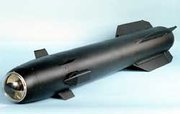AGM-114 Hellfire
|
|
AGM-114 Hellfire (Helicopter launched fire-and-forget) is a U.S. air-to-ground missile system designed to defeat tanks and other individual targets while minimizing the exposure of the launch vehicle to enemy fire. Hellfire uses laser guidance and is designed to accept other guidance packages. It is used on helicopters against heavily armored vehicles at longer standoff distances than any other U.S. Army missiles now in the inventory.
The Hellfire II is the optimized version of the laser family of Hellfire missiles. The Longbow Hellfire Modular Missile System is an air-launched, radar aided, inertially guided missile that utilizes millimeter wave radar technology.
Despite the expanded acronym, most versions of the Hellfire missile are not truly "fire-and-forget"—all the laser guided versions require constant illumination or 'painting' of the target from launch to impact. The AGM-114L is a true fire-and-forget weapon; it requires no further guidance after launch and can hit its target without the launcher being in line of sight of the target.
The Hellfire (along with the Maverick and the air-launched TOW) would have been replaced by the Joint Common Missile around 2010, however as of January 2005 this program has been cancelled. Given the relative youth of the later variants, extensive foreign sales and its particular niche as a truly high precision complement to weapons such as the JDAM, it is likely the Hellfire will be in service for many years.
| Contents |
Combat history
The first shots of Operation Desert Storm occurred on January 17, 1991 when eight AH-64 Apache helicopters used Hellfire missiles and Hydra 70 rockets to destroy two Iraqi early-warning ground control radar sites. However, this was not the first time that Hellfire missiles had been fired in combat. Over a year before, U.S. Army troops successfully used Hellfire against seven targets during Operation Just Cause in Panama. In early 2002, RQ-1 Predator UAVs were armed with Hellfires and used in combat.
The Ground/Vehicular Laser Locator Designator (G/VLLD) was used for designating moving or stationary targets for use with laser-homing weapons such as Hellfire. The G/VLLD could also provide accurate target information for use with conventional artillery. The system was issued to selected field artillery battalions, tank battalions, armored cavalry units, and selected infantry units. Hughes Aircraft Corporation and Optic Electronic Corporation, prime contractors for the system, manufactured the G/VLLD at a unit cost US$164,485.
The Hellfire missile has been used extensively in the 2003 invasion of and ongoing operations in Iraq.
Launch vehicles and systems
- AH-1W Cobra
- AH-64 Apache
- Eurocopter Tiger ARH
- Fighting Boat 90 H
- MH-60R Seahawk
- OH-58D Kiowa Warrior
- P 6297 Hellfire Missile Boat
- Portable Ground Launch System
- MQ-1B Predator
- UH-60 Blackhawk
- Westland WAH-64 Apache
The system has been tested for use on the High Mobility Multipurpose Wheeled Vehicle (HMMWV) and the Improved TOW Vehicle (ITV). Test shots have also been fired from a C-130 Hercules (see photos below). Sweden and Norway uses the Hellfire for coastal defense.
Users
Specifications
- Contractors: Rockwell International Corporation, Lockheed Martin, Northrop Grumman.
- Diameter: 17.8 cm (7 in)
- Wing span: 71 cm (28 in)
- Velocity: 425 m/s (950 mph)
- Minimum range: 0.5 km
Variants
AGM-114A Basic Hellfire
- Target: Tanks, armored vehicles.
- Range: 8,000 m (8,750 yd)
- Guidance: Laser beam riding.
- Warhead: 8 kg (18 lb) shaped charge HEAT.
- Length: 163 cm (64 in)
- Weight: 45 kg (99 lb)
AGM-114B/C Basic Hellfire
- M120E1 low smoke motor.
- AGM-114B has electronic SAD (Safing/Arming Device) for safe shipboard use.
- Unit cost: $25,000
AGM-114D/E Basic Hellfire
- Proposed upgrade of AGM-114B/C with digital autopilot—not built.
AGM-114F Interim Hellfire
- Target: Tanks, armored vehicles.
- Range: 7,000 m (7,650 yd)
- Guidance: Laser beam riding.
- Warhead: 9 kg (20 lb) tandem shaped charge HEAT.
- Length: 180 cm (71 in)
- Weight: 48.5 kg (107 lb)
AGM-114G Interim Hellfire
- Proposed version of AGM-114F with SAD—not built.
AGM-114H Interim Hellfire
- Proposed upgrade of AGM-114F with digital autopilot—not built.
AGM-114K Hellfire II
- Target: Tanks, armored vehicles.
- Range: 9,000 m (9,850 yd)
- Guidance:
- semi-active laser.
- Digital autopilot.
- Electro-optical countermeasures hardening.
- Target reacquisition after lost laser lock.
- New electronic SAD.
- Warhead: 9 kg (20 lb) tandem shaped charge HEAT.
- Length: 163 cm (64 in)
- Weight: 45 kg (99 lb)
- Unit cost: $65,000
AGM-114M Hellfire II
- Target: Ships, caves, urban targets, air defense units.
- Warhead: Blast fragmentation.
- Weight: 48 kg (105 lb)
AGM-114N Hellfire II
- Target: Buildings, bunkers, caves, personnel.
- Warhead: Metal Augmented Charge thermobaric overpressure.
AGM-114L Longbow Hellfire
- Target: Tanks, armored vehicles.
- Range: 9,000 m (9,850 yd)
- Guidance:
- Fire and forget.
- Inertial guidance.
- Millimeter wave radar seeker.
- Home-on-jam anti-radiation mode.
- Warhead: 9 kg (20 lb) tandem shaped charge HEAT.
- Length: 176 cm (69.2 in)
- Weight: 49 kg (108 lb)
Rocket motor
Hellfire-motor-drawing1.gif
- Contractor: Alliant Techsystems
- Designation:
- M120E3 (Army)
- M120E4 (Navy)
- Features:
- Qualified minimum smoke propellant.
- Rod and tube grain design.
- Neoprene bondline system.
- Performance:
- Operating temperature: -43 °C to 63 °C (–45 °F to 145 °F)
- Storage temperature: -43 °C to 71 °C (–45 °F to 160 °F
- Service life: 20+ years (estimated).
- Technical data:
- Weight: 14.2 kg (31.3 lb)
- Length: 59.3 cm (23.35 in)
- Diameter: 18 cm (7.0 in)
- Case: 7075-T73 aluminum.
- Insulator: R-181 aramid fiber-filled EPDM.
- Nozzle: Cellulose phenolic.
- Propellant: Minimum smoke cross linked double based (XLDB).
Photos
See also
External links
- Lockheed Martin - Hellfire II (http://www.missilesandfirecontrol.com/our_products/antiarmor/HELLFIRE/product-HELLFIREII.html)
- Lockheed Martin - Longbow Hellfire (http://www.missilesandfirecontrol.com/our_products/combatvision/LONGBOW/product-LONGBOW.html)
- Designation Systems (http://www.designation-systems.net/dusrm/m-114.html)
- Global Security (http://www.globalsecurity.org/military/systems/munitions/agm-114.htm)
- Navy Fact File (http://www.chinfo.navy.mil/navpalib/factfile/missiles/wep-hellfire.html)ar:هيلفاير


